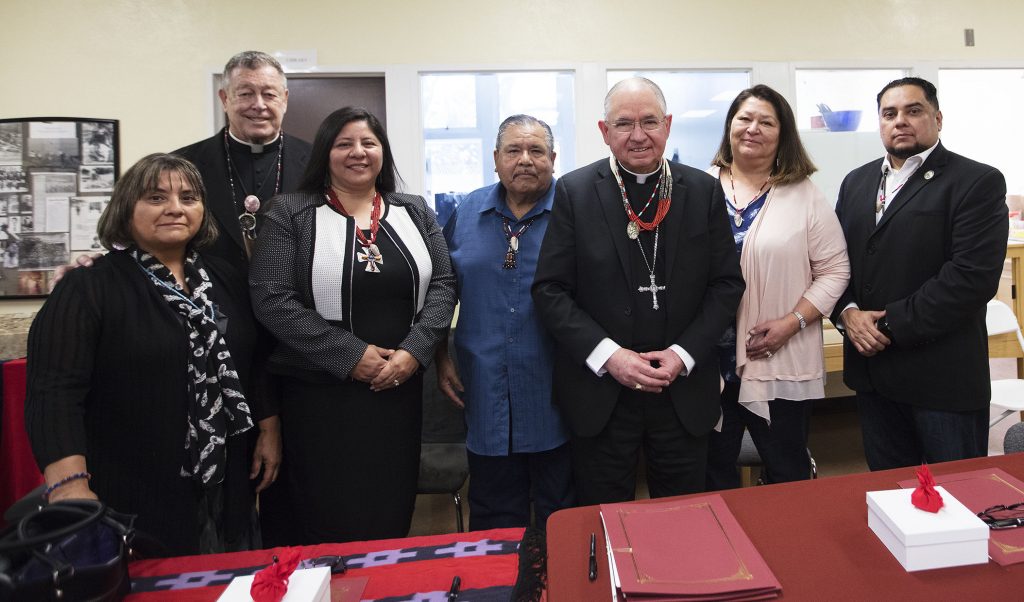A set of historic protocols promises a hopeful start to the next chapter in the relationship between Southern California’s ‘first peoples’ and the Church
“Can we light sage in here?” is not a question most people ask in a room with five bishops.
But for Anthony Morales, chief of the Gabrielino Tongva Band of Mission Indians, the request (in this case, denied by the discovery of smoke detectors) is one he doesn’t expect to have to ask much anymore, at least not when participating in native ceremonies on lands operated by the Archdiocese of Los Angeles.
That’s thanks to the signing of a historic set of 17 protocols by Archbishop José H. Gomez and four tribal leaders — including Morales — from across SoutheCalifornia on March 28 at the Kuruvungna Springs Cultural Center in West LA, the site of one of the Tongva tribe’s ancestral villages.
The signing ceremony was attended by members of several tribes native to SoutheCalifornia, as well as four Los Angeles auxiliary bishops and several priests.
The 17 protocols are an effort to “honor the rich contributions that the ‘first peoples’ of the land have made to the Catholic Church from the beginning,” Archbishop Gomez said at the ceremony.
“On behalf of the Catholic Church, I pledge to stand with you,” the archbishop told representatives from the Chumash, Tataviam, Tongva and Acjachemen Nations. “As your brother and as your friend, I pledge that we will defend and encourage your cultures and languages, your traditions and spirituality.”
The document spells out a number of ways the Catholic Church in Los Angeles can ensure that “indigenous traditional perspectives” are respected and welcomed by its institutions and facilities.
That means not only agreeing to ceremonial requests such as Chief Morales’ to burn sage or tobacco on church grounds, but encouraging Native American participation in the planning of liturgies as well as in indigenous-themed cultural and educational functions hosted by the archdiocese.
The agreement also allows local natives access to traditional ceremonial sites, especially burial areas on the grounds of local missions — which themselves will be required to accommodate tribal members seeking to celebrate the sacraments there.
The efforts to draft the protocols started more than a decade ago, when then-archbishop Cardinal Roger Mahony tasked Auxiliary Bishops Edward Clark and Gabino Zavala with addressing the concerns of Native American leaders who’d had negative experiences with pastors.
“There were valid complaints from the natives about how they were being received and treated at the missions or at parishes,” recalled Bishop Clark in an interview after the ceremony.
Some complained about having to pay the museum entrance fee at missions in order to pray at burials sites. In some parishes, pastors turned away natives hoping to find information about their ancestors from church records.
Eventually, an idea began to take hold: Why not come up with protocols like the ones followed by native tribes? After all, a majority of the area’s natives identify as Catholic. Native American rituals acknowledging the existence of the afterlife and of a single “Creator” were found to be compatible with Catholic liturgies, Bishop Clark said.
With the help of the archdiocese’s coordinator for Native American Concerns, Sylvia Mendivil Salazar, the different tribes began to collaborate on crafting a document.
The mutual sense of goodwill fostered in the following years between native and Church leaders was visible throughout during the ceremony — especially during an exchanging of gifts between the archbishop and tribal leaders — as was the somber recognition of their predecessors’ complicated past.
“We recognize that our shared history has often been a long trail of tears — marked by broken promises, bitter misunderstandings and painful injustices,” Archbishop Gomez said before the signing.
Still, there was optimism that the protocols could help grow what Chief Morales called “the seed that we and the padres planted together.”
Acjachemen tribal leader Teresa Romero admitted she’d had mixed feelings about the protocols. Romero’s ancestors were the first California natives to be baptized near present-day San Onofre, close to the border of Orange and San Diego counties. She said the sufferings of her tribe under the mission system made her hesitate before agreeing to the protocols.
“This is a huge step in the right direction,” said Romero, whose Acjachemen (also known as Juane√±o) territory stretches from northern San Diego County all the way to Long Beach.
She cited her tribe’s custom of conducting native ceremonies during Mass at Mission San Juan Capistrano as an example of what the protocols can help accomplish in other parishes. However, she added, “we still have a lot to work on with the Church.”
Elise Tripp, who signed the protocols on behalf of the Santa Ynez Band of Chumash Indians, credited “very emotional healing times with the Church” with helping her reconcile with “the pain that my ancestors went through” during visits to the Santa Ynez Mission’s burial grounds.
“I have this double thing going on,” Tripp explained. “Being Chumash, and knowing the horrible time that went on, but also having the healing process of being with my ancestors and knowing that they are at peace.”
For native representatives at the ceremony, the permission to visit burial grounds will be one of the most important benefits of the protocols. Fernandeño Tataviam tribal president Rudy Ortega said members have sometimes resorted to trespassing on mission property in order to pray with deceased relatives buried on the property. The protocol ensuring free access to Native American burial sites onrnChurch-owned properties is a sign that “doors are opening for us,” Ortega said.
An open door that Ortega compared to a marriage of two people, each with individual backgrounds and experiences. Or, as Archbishop Gomez described it, a promise to work together “so that our future will be more hopeful than our past.”

